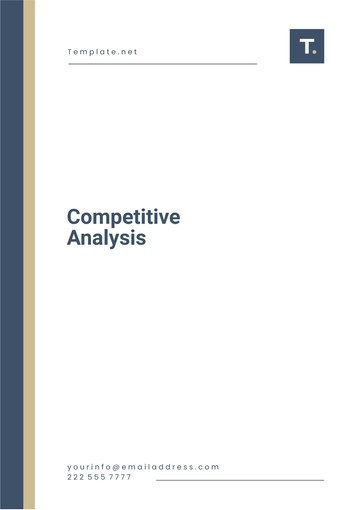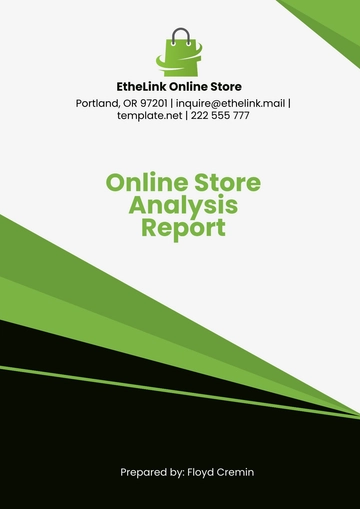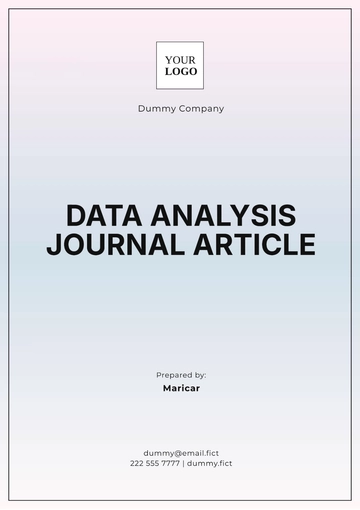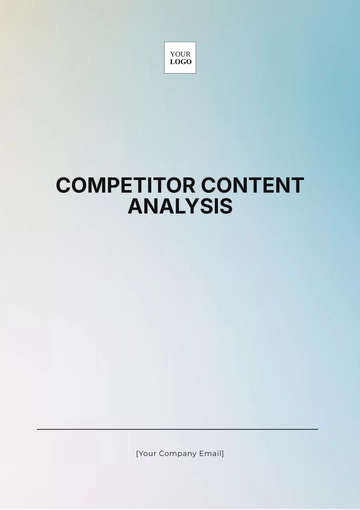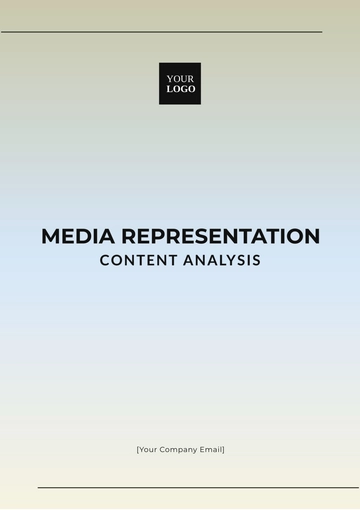Free Travel Agency Strategic Analysis
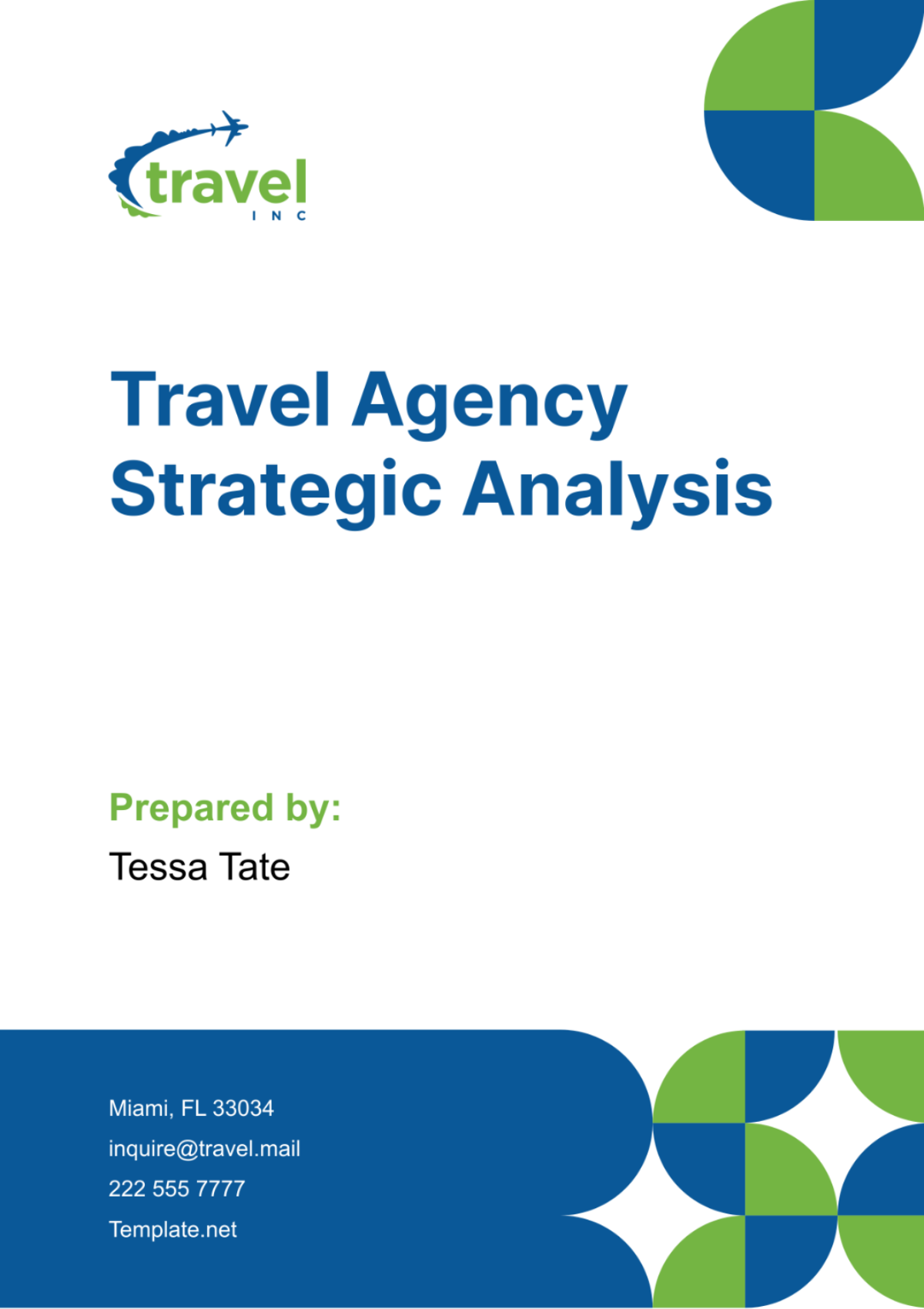
I. Introduction
[Your Company Name] is a leading travel agency dedicated to providing exceptional travel experiences to its customers. With a diverse portfolio of services, including leisure travel, corporate travel management, and adventure tourism, [Your Company Name] has established itself as a trusted partner for travelers worldwide. This strategic analysis aims to assess [Your Company Name]'s current position in the market and identify opportunities for growth and improvement.
II. Market Analysis
A. Market Overview
The global travel and tourism industry is a dynamic and rapidly evolving sector. According to the World Travel & Tourism Council (WTTC), the industry contributes significantly to global GDP and employment. Key trends shaping the industry include the rise of experiential travel, the growing importance of sustainability, and the increasing adoption of technology in travel planning and booking.
B. Segmentation
[Your Company Name] operates across multiple segments within the travel industry:
Leisure Travel: Catering to individuals and families seeking vacation packages, cruises, and other leisure experiences.
Corporate Travel Management: Providing businesses with comprehensive travel solutions, including booking services, expense management, and corporate travel policies.
Adventure Tourism: Organizing adventurous expeditions, eco-tours, and outdoor activities for thrill-seekers and nature enthusiasts.
C. Key Drivers
Several factors drive growth in the travel industry, including:
Economic growth and rising disposable incomes
Increasing globalization and business travel
Shift towards experiential and sustainable travel
Technological advancements in travel booking and navigation
III. Competitive Analysis
A. Direct Competitors
Company Name | Strengths | Weaknesses | Market Share |
|---|---|---|---|
Competitor A | Strong brand presence, diverse product offerings | Limited online presence, higher prices | 20% |
Competitor B | Innovative technology, personalized services | Limited offline presence, smaller customer base | 15% |
Competitor C | Extensive network of agents, competitive pricing | Outdated booking systems, poor customer service | 10% |
Competitor A:
Strengths: Competitor A boasts a strong brand presence in the market, which instills trust and credibility among customers. They offer a diverse range of product offerings, catering to various travel preferences and budgets. Their offline presence through physical locations enhances accessibility for customers who prefer face-to-face interactions.
Weaknesses: Despite its strong brand, Competitor A has a limited online presence, which may hinder its ability to reach tech-savvy customers who prefer online booking channels. Additionally, their prices tend to be higher compared to some competitors, potentially making them less competitive in price-sensitive markets.
Competitor B:
Strengths: Competitor B excels in leveraging innovative technology to enhance the customer experience. They offer personalized services, tailoring travel packages to individual preferences and needs. Their focus on customer-centric solutions fosters loyalty and positive word-of-mouth recommendations.
Weaknesses: Competitor B faces challenges in offline channels, with a smaller physical presence compared to some competitors. This limitation may affect their ability to reach customers who prefer traditional booking methods or face-to-face interactions.
Competitor C:
Strengths: Competitor C has built an extensive network of agents, allowing them to reach customers across various geographical regions. Their competitive pricing strategy appeals to cost-conscious travelers, positioning them as a budget-friendly option in the market.
Weaknesses: Despite its network of agents, Competitor C struggles with outdated booking systems and poor customer service. These weaknesses may lead to customer dissatisfaction and negative reviews, impacting their reputation and market share.
B. Indirect Competitors
In addition to direct competitors, [Your Company Name] faces competition from indirect sources such as online travel agencies (OTAs), travel aggregators, and alternative accommodation providers like Airbnb.
C. SWOT Analysis
Strengths | Weaknesses | Opportunities | Threats |
|---|---|---|---|
Strong brand reputation | Limited online presence | Expansion into emerging markets | Intense competition from OTAs and aggregators |
Diverse portfolio of services | Dependence on traditional booking channels | Adoption of advanced technology | Economic downturns impacting travel demand |
Extensive network of partnerships | Reliance on third-party suppliers | Diversification of product offerings | Political instability and security concerns |
Experienced and knowledgeable staff | Higher operational costs | Growing demand for sustainable travel options | Regulatory changes affecting travel policies |
Strengths: [Your Company Name] possesses several strengths that contribute to its competitive advantage in the travel industry. The company has established a strong brand reputation, instilling trust and credibility among customers, which fosters loyalty and positive word-of-mouth referrals. Additionally, [Your Company Name] offers a diverse portfolio of travel services, catering to various customer preferences and needs, thereby attracting a broader customer base. The extensive network of partnerships forged by [Your Company Name] allows it to access exclusive deals and offer competitive packages to customers. Moreover, the company boasts an experienced and knowledgeable staff, ensuring high-quality service delivery and enhancing overall customer satisfaction.
Weaknesses: [Your Company Name] also faces certain weaknesses that may hinder its growth and competitiveness. One significant weakness is its limited online presence, which could result in missed opportunities to reach customers who prefer online booking channels or research. Additionally, the company's dependence on traditional booking channels may limit its ability to adapt to changing consumer preferences towards online platforms. Moreover, reliance on third-party suppliers may lead to issues with quality control, availability, and pricing, affecting overall service quality. Lastly, managing higher operational costs poses a challenge for [Your Company Name], potentially impacting profitability and competitiveness, particularly in price-sensitive markets.
Opportunities: Despite these challenges, [Your Company Name] has several opportunities to capitalize on to drive business growth and success. One such opportunity is the expansion into emerging markets, allowing the company to tap into new customer segments and geographic regions. Embracing advanced technology, such as online booking systems and CRM software, can enhance operational efficiency and improve the overall customer experience. Furthermore, introducing new travel packages and experiences enables [Your Company Name] to attract a broader customer base and differentiate itself from competitors. Additionally, meeting the growing demand for sustainable travel options aligns [Your Company Name] with consumer preferences and market trends, presenting an opportunity for differentiation and market leadership.
Threats: [Your Company Name] also faces threats that could potentially impact its business operations and market position. Intense competition from OTAs and travel aggregators poses a threat to [Your Company Name]'s market share, as customers may opt for alternative booking platforms. Economic downturns and instability can lead to reduced consumer spending on travel, impacting [Your Company Name]'s revenue and profitability. Political unrest and security concerns in certain regions may disrupt travel plans and deter customers from booking with [Your Company Name]. Moreover, changes in regulations related to travel policies may impact the company's operations and increase compliance costs, posing additional challenges to its business continuity and growth.
IV. Customer Analysis
A. Demographics
[Your Company Name]'s target customers include:
Leisure travelers: Individuals and families seeking vacation packages, cruises, and tours.
Business travelers: Corporate clients requiring comprehensive travel management solutions.
Adventure enthusiasts: Thrill-seekers and nature lovers looking for unique and adventurous experiences.
B. Preferences and Behavior
Price sensitivity: Many customers prioritize cost-effective travel options.
Convenience: Ease of booking, flexibility, and personalized services are highly valued.
Safety and reliability: Trustworthy recommendations and secure travel arrangements are essential considerations.
V. Technology Analysis
A. Online Booking Systems
[Your Company Name] currently operates a proprietary online booking platform, allowing customers to search, compare, and book travel services conveniently. However, there is room for improvement in terms of user experience and mobile accessibility.
B. Customer Relationship Management (CRM)
Implementing a robust CRM system can enhance customer engagement and loyalty by providing personalized recommendations, targeted promotions, and efficient communication channels.
VI. Regulatory Analysis
[Your Company Name] must stay abreast of regulatory requirements governing the travel industry, including:
Licensing and certification: Compliance with industry standards and regulations for travel agencies.
Data protection: Adherence to data privacy laws when handling customer information.
Travel advisories: Monitoring and communicating travel advisories and safety guidelines to customers.
VII. Financial Analysis
Category | Amount (USD) |
|---|---|
Revenue | $5,000,000 |
Cost of Goods Sold | $3,000,000 |
Gross Profit | $2,000,000 |
Operating Expenses | $1,200,000 |
Net Income | $800,000 |
Revenue: [Your Company Name] generates revenue through commissions on bookings, service fees, and markups on travel packages. Revenue streams are diversified across leisure, corporate, and adventure travel segments.
Operating Expenses: Major expenses include salaries, marketing costs, technology investments, and supplier payments. Managing operational costs and optimizing efficiency are critical for profitability.
VIII. Strategic Recommendations
Based on the findings of the strategic analysis, the following recommendations are proposed for [Your Company Name]:
Enhance online presence: Invest in website optimization, SEO, and digital marketing to capture a larger share of online bookings.
Expand product offerings: Introduce new travel packages and experiences to cater to diverse customer preferences and emerging market trends.
Strengthen partnerships: Forge strategic alliances with airlines, hotels, and tour operators to access exclusive deals and enhance customer value.
Embrace technology: Upgrade online booking systems, implement CRM solutions, and leverage data analytics to improve customer engagement and operational efficiency.
Focus on sustainability: Promote eco-friendly travel options, support local communities, and align with sustainable tourism practices to appeal to environmentally conscious travelers.
IX. Conclusion
In conclusion, the strategic analysis conducted for [Your Company Name] provides valuable insights into its current position in the travel industry and outlines potential pathways for future growth and success. By leveraging its strengths, addressing weaknesses, and capitalizing on opportunities, [Your Company Name] can enhance its competitive position and drive sustainable growth in the dynamic and competitive travel market. Through strategic partnerships, technological innovation, and a focus on customer satisfaction, [Your Company Name] is well-positioned to navigate challenges and capitalize on emerging trends, ensuring continued success and leadership in the travel industry.
- 100% Customizable, free editor
- Access 1 Million+ Templates, photo’s & graphics
- Download or share as a template
- Click and replace photos, graphics, text, backgrounds
- Resize, crop, AI write & more
- Access advanced editor
Develop a winning strategy for your travel agency with Template.net's Travel Agency Strategic Analysis Template. Easily editable in our AI Editor Tool, this customizable template provides a structured format for assessing internal capabilities, market opportunities, and competitive landscape to formulate effective business strategies. Enhance decision-making, drive growth, and achieve your agency's goals!
